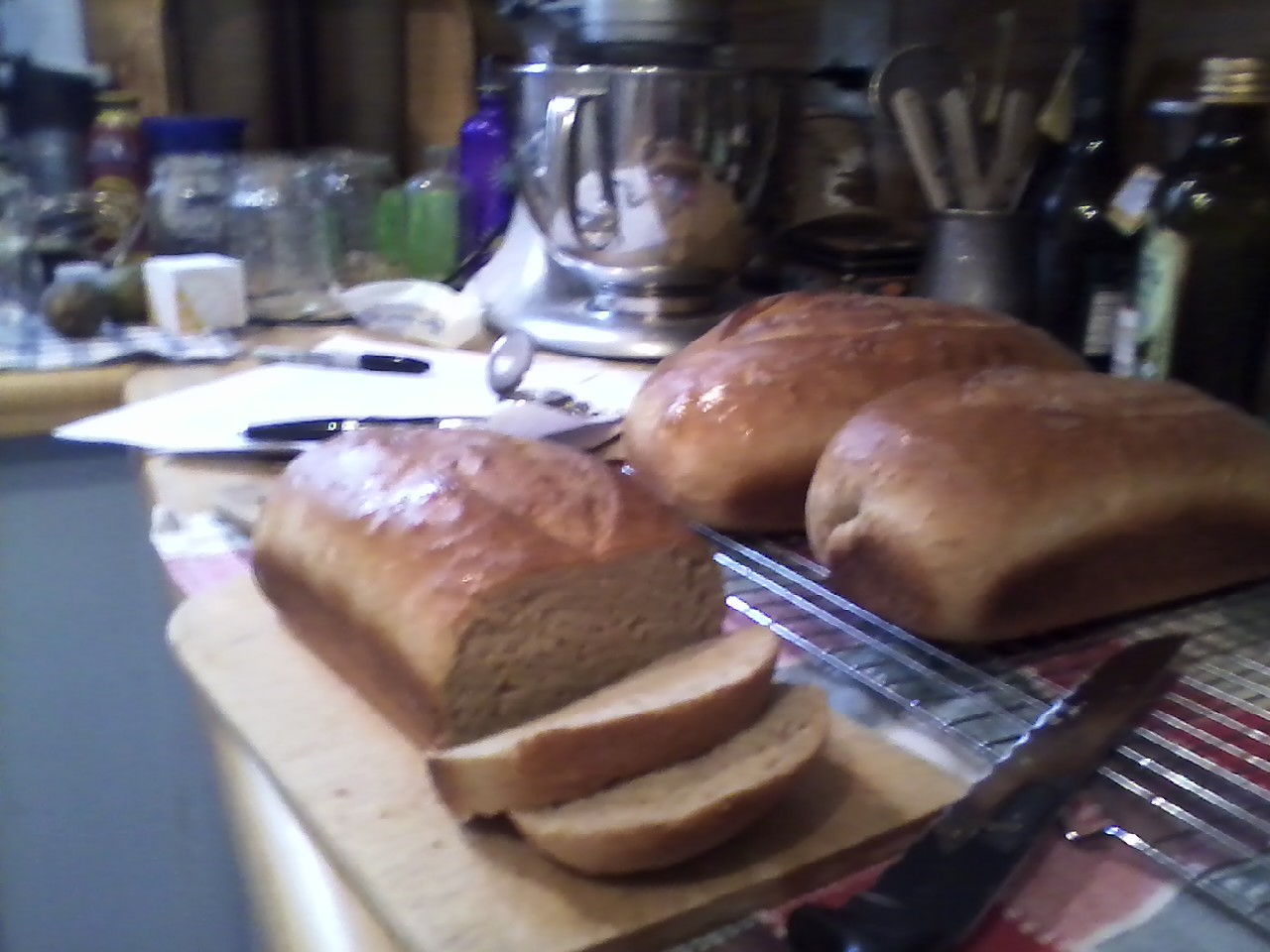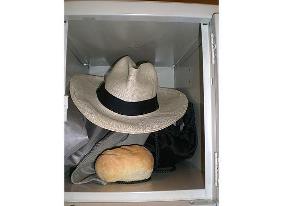Basic Wholesome Wheat Bread Recipe
Ingredients:
3 1/2 cups warm water
2 Tbsp. Honey
2 Tbsp. Yeast (maybe 3 envelopes?)
1Tbsp. Salt
8-9 cups, give or take, of whole wheat (3 cups) and bread flour (6+ cups); Yeah, yeah, I don’t have an exact amount because there isn’t an exact amount–I live in a very humid, even damp, part of the country, if you are actually dry, you will need less flour. Using more whloe wheat will also require less wheat overall. I really, really love King Arthur Flour, and start with 2 cups of King Arthur Whole Wheat, then 2 Cups of King Arthur White Wheat, and then 5 or more cups of King Arthur Bread Flour, but you go with what you have.
Step 1, Proofing: In a large bowl (or the mixer bowl if you plan on letting the bread hook to the heavy lifting); whisk in the 2 Tbsp. of Honey, and the 2 Tbsp. of Yeast; mix until smooth. Whisk in the first 3 cups of flour–I usually move from the coarsest flour to the smoothest, so the wheat flour here. Now leave this in a warm place for 5 minutes and walk away. Fold laundry, try to figure out where you put the bread flour, dance, just leave the yeast alone.
Step 2, Kneading: Come back, Little Sheba. If it is bigger, and a little poofy, the yeast is doing great. If not, either you have bad yeast or a cold spot. Whisk down this living thing in the bowl, and add 1 Tbsp of Salt. Add in the Bread Flour 1/4 of a cup at a time, and thoroughly mix it in; when the whisk becomes impractical, use a big wooden spoon, when this is too hard, use a mixer with a bread hook or turn it our onto a floured surface. It is important to knead the flour in 1/4 of a cup at a time, and after each bit of flour, hook or knead the bread until it becomes one thing again–not a mixture of flour and dough, but one unit. When the dough is a single round thing holding on to itself and not sticking to other things, behaving about like a deflated volley ball, it is ready. The amount of the flour doesn’t matter–getting it to this proper consistency is what matters. Roll it around on the counter for good measure.
Step 3, Rising: Grease a smooth bowl 3 times as big as the dough. Roll the dough ball in the oil, and then cover with plastic wrap or a wet towel or something that will let it slip without drying out. Let this sit in in a warm place–in the oven with a heating pad on a different shelf, on the sunny side of the house, just a safe and warm place–until the dough has doubled in size. Usually, this will be about an hour.
Step 4, Second Rising: Grease 3 bread pans, or 2 bread pans and 2 little pans, or some such combinations. Turn the dough out onto a clean surface, and punch it down (forcefully knead it), which should reduce it to close to its original size. Separate this into 3 portions ( or 4 or… you figure it out) and shape these into loaves; make sure that there are not seams or spots the loaf might separate, maybe pinching loose edges and rolling it about a bit–each should be smooth and coherent–it’s own little self. Put each loaf into a pan, slit along the top with a sharp knife (this lets bubbles out) and set these into a warm place until they have grown–usually less that the first rise. about half way through this rise (20? 25 minutes?) pre-heat the oven to 400 degrees.
Step 5, Baking: put them in the oven for 30 or 35 minutes, until the top crust is a nice dark brown. figure out your oven, and see if you need to turn them or rotate them to get them to cook evenly. When they are done, get them out, take them out of the pans, and put them on a cooling rack. Usually, at this point, I take a little butter and polish the top with them, but one doesn’t have to.
 Last Step, Sharing: You may have noticed I made 3 loaves. You can, of course, use division and figure out how to make a smaller batch, but I suggest you make 3, and then figure out why you needed 3. The bread might be so good that one loaf is eaten before it even cools. Most importantly, if you have extra bread, you will have to give it away. Give it to a wandering Buddhist monk, a musician or a college student–all of these are good karma. You might give some to somebody you love, or whom you wish to love, or who needs to feel loved. My mom says it is just as easy to pray for somebody while kneading bread as it is just to pray for somebody; I don’t understand prayer, but I know everybody needs to feel loved and everybody loves good bread.
Last Step, Sharing: You may have noticed I made 3 loaves. You can, of course, use division and figure out how to make a smaller batch, but I suggest you make 3, and then figure out why you needed 3. The bread might be so good that one loaf is eaten before it even cools. Most importantly, if you have extra bread, you will have to give it away. Give it to a wandering Buddhist monk, a musician or a college student–all of these are good karma. You might give some to somebody you love, or whom you wish to love, or who needs to feel loved. My mom says it is just as easy to pray for somebody while kneading bread as it is just to pray for somebody; I don’t understand prayer, but I know everybody needs to feel loved and everybody loves good bread.
Note: this recipe is adapted from Family Fun’s Family Cookbook. I know, it’s Disney, but it is a great cookbook.

Funny that “bread, please” was my first response to your offer to help me after Adam died.
Very nice. But do you offer a Manichean alternative – unwholesome wheat bread?